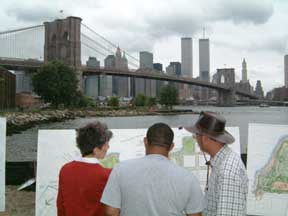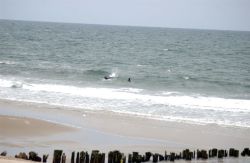Jamaica Bay and the Rockaways
The Daily Plant : Tuesday, July 31, 2001
IN BROOKLYN: FROM BLUEPRINT TO PARKLAND

Photo by Malcolm (Cinema) Pinckney
On Thursday, July 26, 2001 the Parks broke ground on a project twenty years in the making. A 1.5-acre parcel of land at the foot of Main Street became the first new segment of a far-reaching plan to transform 70 acres of the formerly industrial Brooklyn waterfront. When complete, the park will recast the banks of the river in Downtown Brooklyn as a quintessential New York destination, a place where visitors enjoy expansive views of New York Harbor and glimpses into its history. Parks' contribution will be a spectacular public park with views of the Manhattan skyline, a beachfront, and a nautical-theme playground.
This new park lies within the historic district of Fulton Ferry, now known as Down Under the Manhattan and Brooklyn Bridges Overpasses (DUMBO). When the first commercial ferry service between Long Island and New Amsterdam started in 1642, the neighborhood was established as an important hub for maritime commerce. From 1850 to 1912 the Catharine Slip Ferry carried passengers from Main Street-the site of our emerging park-to the shores of Manhattan. Among the thousands to ride the Catharine Slip Ferry each year was American poet Walt Whitman. Inspired by the thrill of the passengers, the beauty of the shores, and the power of the river, he penned the poem, Crossing Brooklyn Ferry. With the completion of the Brooklyn and Manhattan Bridges in 1883 and 1902, ferry service dwindled, but the Brooklyn waterfront remained an active port for many years.
The decline of maritime commerce coupled with a surge in the area's residential population helped inspire community dreams of a waterfront park. In 1998, at the urging of the community-based Brooklyn Bridge Park Coalition, elected officials and community residents formed the Brooklyn Bridge Park Development Corporation (BBPDC) to create a master plan for a 1.3-mile park stretching from the Manhattan Bridge to Atlantic Avenue on City, State, and Port Authority properties.
Like other industrial sites along the shoreline, this property might have remained a parking lot had it not been for a strong competing vision. Mayor Rudy (Eagle) Giuliani recognized the merits of the park plan, and decided to take action. At his State of the City Address in January 2001, the Mayor assigned Parks to plan and design a green space there, and allocated $6 million for the work. Commissioner Henry J. (StarQuest) Stern and a team of Parkies assessed the BBPDC's master plan and met with local organizations as well as representatives from Community Board 2 and Empire Fulton Ferry State Park. From this, they developed a design to strengthen connections between the Main Street property and the neighboring State park, and a concept plan for all City-owned parcels within the proposed park boundaries.
Parks' landscape architects Dennis (Phinsfan) Flynn, Hui Mei (Bamboo) Grove, Marcha Johnson, Nancy (Designing Woman) Prince, and Emmanuel Thingue have designed a park for all people. Through an ornamental gate visitors will enter the park. Paved walkways will lead parents and children to a playground inspired by the history of the Harbor. In view of the "frolicsome crests" and the "scallop-edged waves" of Whitman's poem, they'll climb aboard a 50-foot ship's hull and bathe in a spray shower disguised as a ferryboat. A view of a tall nautical flagpole will seal the impression: kids command the waterways.
Other visitors will be tempted, as Whitman was, by the "reflection of the summer sky in the water" and the "sea-birds wheeling" above. They will have the chance-exceptional for a city park-to sit at the edge of the water and let the waves lap over their toes. Our beach bears the good fortune to lie within a cove where the river is relatively calm. The cove, which we share with our neighbor, Empire Fulton Ferry State Park, makes an ideal habitat for shellfish and shoreline plants like sumac, butterfly weed, little bluestem, beach plum, and juniper. The view from the summit of a 15-foot hill at the center of our park, will be breathtaking. The construction, to be overseen by Bill (Captain) Walsh, Director of Brooklyn Construction and Ricardo Mark, Project Resident, and carried out by William A. Gross Construction will be completed next summer. The playground is expected to be open for use as early as November.
Special thanks to Alan (Northside) Moss, First Deputy Commissioner; Julius (Mirror) Spiegel, Brooklyn Borough Commissioner; Joshua (Sirius) Laird, Chief of Planning; Paul (Polecat) Ersboll, Chief of Design; John (Wildcat) Natoli, Chief Engineer; Mary (Catalyst) Pazan, Chief of Management Services; David (Landscape) Carlson, Director of Landscape Architecture; and Arjun (Energy) Sheth, Director of Engineering, who guided the work.
Mayor Giuliani; Commissioner Stern; Deputy Mayor Anthony (Anthracite) Coles; and Joanne (Greenheart) Witty, President of the Brooklyn Bridge Park Local Development Corporation all spoke at Thursday's groundbreaking. Mayor Giuliani announced the City's commitment to develop more land at the base of the Brooklyn Bridge. Thursday morning it was confirmed that the City will demolish The Purchase Building, a DCAS-owned scrap yard and storage facility, for parkland. Mayor Giuliani committed $8 million to the project, which will create a prominent entrance to Brooklyn Bridge Park, and expose more exceptional views.
Watch a webcast recording of the Commissioner's speach at the event.
THIRTEEN YEARS AGO IN THE PLANT
(Tuesday, August 2, 1988)
JANET TIMLIN MAKES HISTORY AS
FIRST FEMALE CHIEF LIFEGUARD
Janet Timlin made a big splash this summer when she became the first female Chief Lifeguard at a New York City beach. Her promotion to the supervisory position at Rockaway Beach in Queens is the culmination of a 20-year drive by Parks to bring women to a traditionally male-dominated field.
QUOTATION FOR THE DAY
"Just as you feel when you look on the river and sky, so I felt; ... Just as you are refresh'd by the gladness of the river and the bright flow, I was refresh'd."
Walt Whitman (1819-1892)
Check out your park's Vital Signs
Clean & Safe
Green & Resilient
Empowered & Engaged Users
Share your feedback or learn more about how this park is part of a
Vital Park System

Know Before You Go
Ecology Park is only open at certain times of year when Parks staff are present in order to protect this unique landscape. Want to visit? Check out our Stewardship Projects page for restoration, planting, and educational events.



